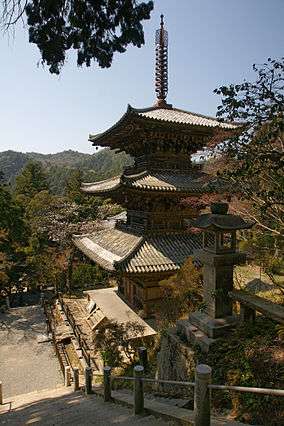Benchō
| Part of a series on |
| Buddhism in Japan |
|---|
 |
Benchō (弁長, June 20, 1162 – March 16, 1238), is considered the second patriarch of the main Chinzei branch of the Jōdo-shū sect of Japanese Buddhism, after Hōnen. He is often called by another name: Shōkōbō Benchō (聖光房弁長) or just Shōkō. According to biographies, he first ordained as a priest of the Tendai sect at the age of fourteen, and entered Enryaku-ji temple in 1183. He first met Hōnen in 1197. Later, after Hōnen and many of his followers were exiled in 1207, Shōkō was exiled on the island of Kyūshū and taught the practice of the nembutsu there.
Unlike other disciples of Hōnen, Shōkō favored studying the more traditional Buddhist paths along with the Pure Land path. He also criticized the interpretations by other disciples of Hōnen, particularly Kōsai and Shōkū, who emphasized the nembutsu over other practices. However, unlike Chōsai, his teachings still emphasized repeated recitations of the nembutsu as the primary practice in Jōdo-shū. In the spectrum of followers of Hōnen, Benchō balances faith in the nembutsu with acceptance of other practices leading to rebirth in the Pure Land of Amida Buddha.
After Hōnen died, Benchō attempted to counter divergences in Hōnen's teachings among other disciples by writing a treatise titled Matsudai Nenbutsu Jushuin (末代念仏授手印 "Handprint for the Transmission of the Nembutsu to Future Generations"), which contained a full account of the teachings that Benchō heard directly from Hōnen. He also wrote The Way of Practice for Birth by the Nembutsu (nembutsu ojo shugyomon) to counter teachings from other disciples of Hōnen, particularly Kōsai and the "single-nembutsu" movement.
Benchō died in 1238 and was succeeded by the third patriarch, Ryōchū (良忠, 1199–1287), who formally established Chinzei branch.
Quotations
| “ | People maintain that the best place for a life of retirement is the Kokawa Temple or Mount Koya. But as for me, there is nothing to compare with the bed from which I rise every morning. | ” |
References
- Traversing the Pure Land Path : A Lifetime of Encounters with Honen Shonin. Jodo Shu Press. 2005. p. 149. ISBN 4-88363-342-X.
- Hattori, Sho-on (2001). A Raft from the Other Shore : Honen and the Way of Pure Land Buddhism. Jodo Shu Press. p. 10. ISBN 4-88363-329-2.